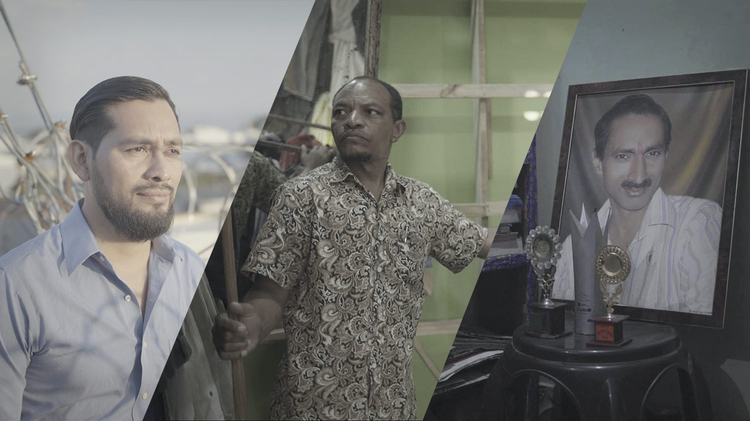
Mines’ dirty secrets echo on three continents
2019년 06월 21일 11시 24분
| Korea Center for Investigative Journalism(KCIJ)-Newstapa publishes the investigation results of cross-border investigation project ‘Forbidden Stories’. KCIJ-Newstapa and 15 partners from all across the world including the Guardian and Le Monde participated. The Forbidden Stories is a non-profit project led by Freedom Voices Network to continue and complete works of those fellow investigative journalists who were threatened, jailed or murdered. The project has completed the suspended works of Daphne Caruana Galizia, an investigative journalist at Times of Malta who was killed in a car bombing while working in Oct. 2017, and published it in April 2018. |
On the 26th of March 2018, a journalist and a photographer from Ecuador as well as their driver were kidnapped by former FARC guerillas on the border with Colombia while they were working on a story about drug-trafficking. They were found dead three months later. A group of nineteen Ecuadorian and Colombian journalists, in partnership with the organization “Forbidden Stories”, carried out an investigation into the death of their colleagues.
Korea Center for Investigative Journalism(KCIJ)-Newstapa and 15 other international media are publishing the outcome of this investigation on Oct. 24, 2018.
A name delicately handwritten in a hotel register: Javier Ortega. Occupation: journalist. This is the last proof of life left by the Ecuadorian reporter of the daily El Comercio, on Monday, the 26th of March 2018. At 7:10am, he appears on surveillance videos as he leaves hotel El Pedregal, in northwestern Ecuador, accompanied by the photographer Paúl Rivas and their driver Efraín Segarra. They are heading to Mataje, the last village before the Colombian border.
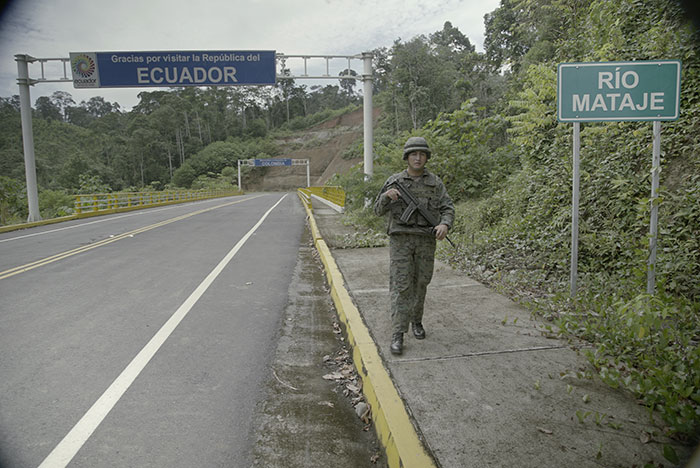
Their bullet-riddled bodies are found only three months later by the Colombian Special Forces, dozens of kilometers away, in the region of Nariño where numerous groups of narco-traffickers operate. Their murderers dug two graves, which they conscientiously booby-trapped using five antipersonnel landmines, intended for causing damage when soldiers came to recover the bodies. According to the Colombian prosecution’s preliminary investigation – which we had access to – it took elite troops more than eight hours to secure the area.
“At the morgue, I asked the director of the Forensic Medicine Institute to see my father’s body. I still couldn’t believe he was dead,” says Cristian Segarra, son of the driver Efraín Segarra. “He told me that it was going to be complicated, that his face was unrecognizable. They finally let me see his hand, but it was in such a state of decomposition that I almost didn’t recognize it.”
It was the final episode of a tragedy that devastated Ecuadorian society. On social media, in the streets of Quito the capital, on the windshields of cars, the slogan #nosfaltan3 [#wearemissing3] spread. Never had a journalist been kidnapped and murdered in Ecuador before. The country had succeeded in preserving the peace in its territory while its neighbor Colombia sank into a bloody civil war with the Revolutionary Armed Forces of Colombia (FARC).
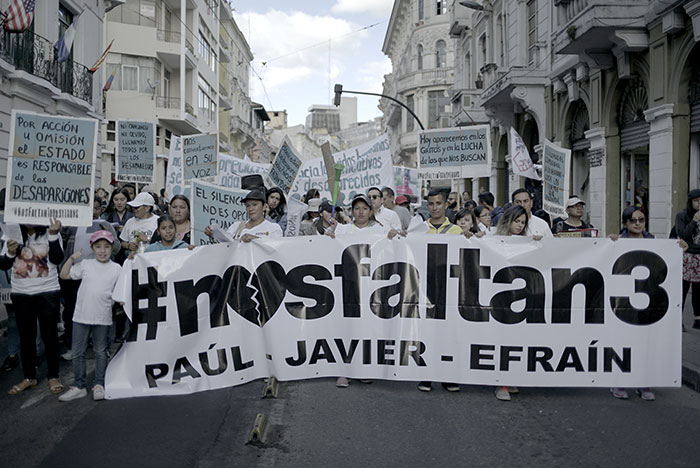
Numerous gray areas linger as to what exactly happened in the steep jungle that serves as the border between the two countries. Under which conditions and why were the three employees of the daily El Comercio kidnapped and murdered? Did the Ecuadorian government do everything possible to rescue them? A group of Ecuadorian and Colombian independent reporters got together to try to respond to these questions. For security reasons, they worked under cover of anonymity. “It’s an extremely sensitive issue here, we cannot take the risk of one of us getting killed, by signing our articles with our real names,” explains one of them. The organization Forbidden Stories, devoted to continuing and completing the work of threatened, jailed, or murdered journalists, joined their investigation to understand what happened after Javier Ortega and his two colleagues disappeared on the morning of Monday, the 26th of March.
“I said to Paúl: ‘don’t go this time, please! I think it’s too dangerous,’” remembers Yadira Aguagallo, photographer Paúl Rivas’s companion, in their apartment where she now lives alone. It was the third time since the beginning of the year that he was going to the border area for a story. “He responded: ‘it’s my job,’”, she continues. “When we woke up, I saw him next to me and I thought I couldn’t continue living if something happened to him.” Six days earlier, three soldiers had been killed and one injured in a home-made bomb blast in Mataje. This was the latest jolt in a wave of violence that had been rattling the province of Esmeraldas, on the border with Colombia, in the past several months. On the 27th of January 2018, the police station in San Lorenzo, one of the main cities in the area, was the target of a car bomb attack. 28 people were injured. Ecuadorian president Lenín Moreno declared a state of emergency in the region and imposed a curfew. The authorities blamed one man for this series of attacks: Walther Patricio Arizala Vernaza, a.k.a. “El Guacho”. Only 28 years old and unknown to the authorities until a few months before, he quickly became public enemy number 1. In the only interview he gave to the Colombian TV station RCN in October 2017, he appears relaxed, wearing not his army fatigues but a dressy blue polo shirt; only the heavy machine gun on his shoulder gives away his real activity. This former FARC guerilla is believe said to be the leader of a group of 120 armed men: the Oliver Sinisterra Front.
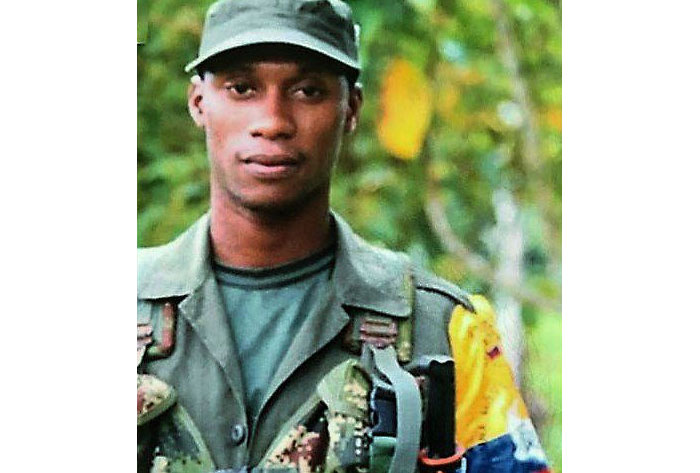
“The peace accord [signed in November 2016 between the Colombian government and FARC] mostly benefited the movement’s commanders. The government proposed to the other militias to free up land where they could grow maize, coffee, or potatoes. It’s much less appealing than what drug trafficking can bring,” says Colonel Mario Pazmiño, former director of the Ecuadorian Military Intelligence Services between 2007 and 2008. “Between 1800 and 2000 guerillas dissented.” Today, there are reportedly a dozen groups that operate in the border region between Ecuador and Colombia. As a response to the emergence of these groups of drug-traffickers, accused of working hand in hand with Mexican drug cartels, the authorities in both countries imposed tougher security measures.
The attacks in the past few months are a “consequence” of these operations, according to Christian Rivadeneira, the prosecutor in charge of investigating the wave of attacks in the Esmeraldas region. “They appear to be reprisals,”, he explains.
According to the United Nations Office on Drugs and Crime, coca production flourished in Colombia in 2016, particularly in the Nariño region where these armed groups operate. 42 627 hectares were said to be cultivated, a 43% increase from 2015.
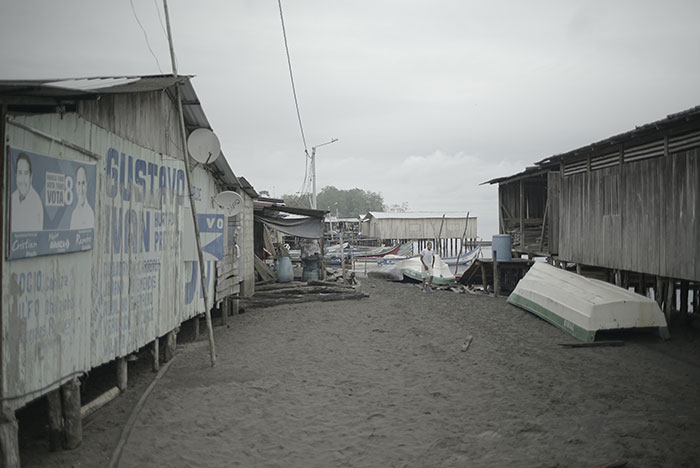
“Once coca leaves are transformed into cocaine in Colombia, the drugs are smuggled to Ecuador via sea or land, where they are stored and then transported to Central America, Mexico or the United States by fishermen recruited by drug traffickers,” the prosecutor Christian Rivadeneira explains.
The mountainous region, the dense forest, and the giant mangroves where the drugs pass through, make the operations of the Special Forces extremely complicated.
“Why is this a taboo subject in Ecuador? Why doesn’t the government want people to talk about it?” Colonel Mario Pazmiño asks. “Because it shows to the national and international public that this border is out of control, that its inhabitants are left to their fate. In these conditions, how do you expect them not to collaborate with narco-traffickers?”
It is to report on the consequences of this drug war that Javier Ortega and his two colleagues go to the border village of Mataje on the 26th of March. The particularly dangerous zone is known to be in the hands of El Guacho’s men. At 9:30am, according to the Ecuadorian interior ministry’s investigation report, they cross the last military barricade situated a few kilometers from the village. This is where we lose track of them, until the 3rd of April.
A video, aired by the Colombian TV channel RCN, shows the journalists in chains, their faces distraught. Javier Ortega calls out to the Ecuadorian president Lenín Moreno: “Our lives are in your hands.” The journalist relays the demands of their abductors: the release of three drug-traffickers from prison and an end to the agreement between Colombia and Ecuador for military collaboration on the border. At the end of the video, he confirms what everyone feared, that the three employees of El Comercio were kidnapped by El Guacho’s group.
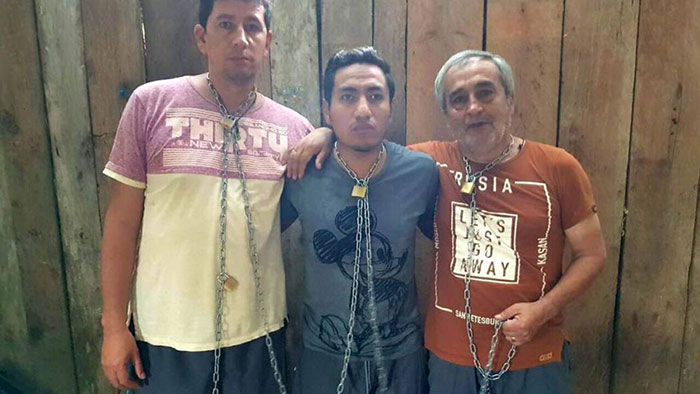

Only one press team, escorted by Ecuadorian soldiers, was able to enter Mataje since the death of Javier Ortega and his colleagues. It is our turn to go there, with the army, on the 2nd of August.
Two cracked asphalt roads, houses made of cinder blocks, children playing in their school uniforms, and a few hundred meters away, on the other side of the river that marks the border, coca fields. Here, soldiers make their daily rounds in armored vehicles, but there is no permanent control of the bridge that leads to Colombia, which leaves the way open to narco-traffickers. In the middle of this village abandoned by the authorities, a brand-new building stands out.
“It’s the house of El Guacho’s mother,” explains Colonel Rodriguez who is accompanying us. The journalists’ car was found a few dozen meters away. “The house is empty, but reportedly El Guacho passes by regularly,” he continues. We are not allowed to get out of the vehicle to speak with the inhabitants. A few minutes later, speakers start playing reggaeton music all around the village. A signal sent to the other side of the border to let them know about our presence.
One person accepted to speak to us about what happened in Mataje the day of the kidnapping. Victor Hugo Guerrero Quiñónez received us at his home in one of the poor neighborhoods of the town of San Lorenzo, some 25 kilometers from the village. He taught at the primary school in Mataje for two years until he had to quit his job during the wave of attacks. He was not there when the employees of El Comercio disappeared, but collected eyewitness accounts from his former students and colleagues.
“They parked their car and attempted to ask some questions to the inhabitants,”, he says.
But people don’t like to talk around here, it’s the code of silence. They asked some children where the bridge was that led to Colombia. The children told them, and then, they disappeared.
What exactly happened to Javier Ortega and his two colleagues? There are several theses about this, and they are often contradictory.
On the 6th of August, the Colombian defense ministry announced that a suspect known as “Roberto” was arrested. “According to the information known to the intelligence services, he is believed to have stopped the El Comercio press team in Mataje and lied to them to take them to Colombia,”, the ministry affirms on its Twitter account. A thesis challenged by the Colombian prosecutor’s office. According to the preliminary information presented on the 23rd of July 2018 at court in Bogotá, it appears that the journalists were taken hostage by “Roberto” and an accomplice in Mataje, before being taken to Colombia. This an extremely sensitive point for the Ecuadorian government, accused by the families of not accepting its own responsibilities in this case.
Questioned on the 19th of July during a press conference, defense minister Oswaldo Jarrín denied that the journalists were kidnapped on Ecuadorian soil. “It’s disgraceful! How can he make such an irresponsible statement?” objects Cristian Segarra, the son of Efraín Segarra, the driver. “They want to put the blame on the Colombian state. I think they simply failed to bring them back alive.”
For months now, families of the victims have been taking turns to denounce to the media the amateurism of the government, which they hold responsible for the death of their loved ones. “During those 19 days [that the kidnapping lasted], they lied to us,” affirms Yadira Aguagallo, photographer Paúl Rivas’s companion. “We had the feeling we were abandoned in the worst possible way. They were saying one thing one day and exactly the opposite the next day. They told us that they were negotiating with the aggressors, and then the minister announced during a meeting with the international press that this was not the case.”
WhatsApp conversations between El Guacho and Major Alejandro Zaldumbide, a high-ranking Ecuadorian police officer, are a source of embarrassment for the government today. These exchanges, handed over to the courts, suggest that in the days prior to the kidnapping, the authorities were aware of the increasingly pressing danger to civilians.
On the 16th of March 2018, El Guacho, visibly infuriated by the security operations in Mataje, writes to the Major: “I am losing patience, if we catch any civilians on the border, we’ll kill them.” “Just a few hours before Javier and his team entered Mataje, access was forbidden to journalists,” explains Geovanny Tipanluisa, Javier Ortega’s editor-in-chief at the daily El Comercio. “Yet they made them sign the register and let them pass. What happened? I still don’t have an answer.”
Despite our requests, the government did not respond to our questions. “It annoys them that in Ecuador or in the rest of the world, people will know they made an error,” reckons Galo Ortega, father of the journalist Javier Ortega.
And what if the hostages could have been freed? On the 28th of March, El Tiempo, one of the most reputable daily newspapers in Colombia, announces their release. At 9:25pm, the newspaper affirms that they were returned in good health to the Ecuadorian authorities and that they were near the village of Mataje. “Everyone was crying here! It was such an incredible joy!” remembers Geovanny Tipanluisa, the editor-in-chief of El Comercio.
But the Ecuadorian government is slow to confirm the information. Interior minister César Navas speaks only the next morning, to deny the release, and to affirm that negotiations are still underway.
However, a judicial source gives us a totally different version of the facts. According to this source, around 6pm, an order is given to keep a military helicopter ready to receive the hostages. They are then to be taken to the Colonel Carlos Concha Torres airport in the town of Tachina, where a plane is supposed to transfer them to Quito.
According to our information, the same evening, the Colombian defense minister at the time, Luis Carlos Villegas, apparently called his Ecuadorian counterpart Patricio Zambrano to congratulate him for the release. Interviewed on the 28th of September, Mr. Zambrano, who is no longer minister, confirmed Mr. Villegas’s phone call but denied that a plan to pick up the hostages had been activated. He added: “The only news [concerning the release] that we ever had was the El Tiempo article (…) which was a false information.” What really played out on that evening of the 28th of March? “This is one of the biggest questions I have today,” Cristian Segarra says. “I think it will stay that way all my life, as long as the investigations fail to get to the bottom of what happened.”
On the 11th of April, the Oliver Sinisterra Front issued a press statement announcing the assassination of the three employees of El Comercio. The testimony of a reformed group member to investigators in Colombia revealed what was to be the last exchange between the hostages and their kidnappers: “the journalists’ driver (...) asked what would happen to them, whether they would be killed. Peru [one of El Guacho’s men] responded, yes, (...) because the Ecuadorian government had not respected the agreement. Then they started shooting.”
Several people close to El Guacho were arrested and indicted in Colombia, but he remains at large. The manhunt underway to catch him keeps the two countries on their toes.
On the 15th of September, Colombian president Iván Duque announced that El Guacho was wounded during a military operation, before the army chief of staff, General Alberto José Mejia, backed out three days later, saying: “I can neither confirm nor deny that.” The Ecuadorian government is offering an award of 100 000 dollars, and the Colombian authorities 148 000 dollars, for any information that will help capture him, dead or alive.
“As Paúl’s companion, it hurts me to think that there had to be a kidnapping and a murder for them to start caring about what is happening at the border,” Yadira Aguagallo decries.
We closed our eyes. The Colombian and Ecuadorian governments carry a big share of the responsibility in this. The death of Paúl, Javier, and Efraín cannot go unpunished. Justice has not been served at any level. Some silences are unsustainable.
Reporting by: ‘Forbidden Stories’ Jules Giraudat, Fundamedios, Foundation for Press Freedom(Flip), Verdad Abierta, Periodistas sin cadenas, Organized Crime and Corruption Reporting Project(OCCRP), La Liga Contra el Silencio
뉴스타파는 권력과 자본의 간섭을 받지 않고 진실만을 보도하기 위해, 광고나 협찬 없이 오직 후원회원들의 회비로만 제작됩니다. 월 1만원 후원으로 더 나은 세상을 만들어주세요.